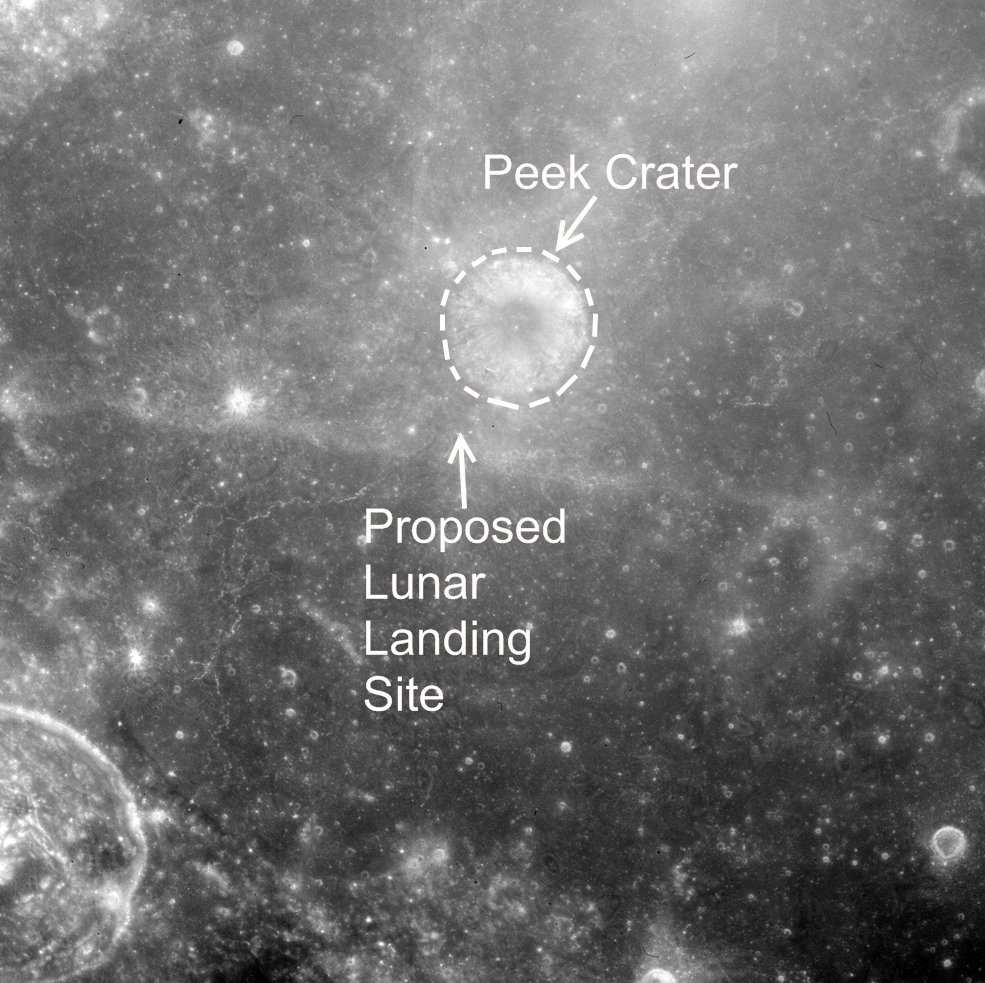
| Project Home | About the Scans | Browse Gallery | Image Map | Support Data | Resources | Ephemeris |
Featured Image - (04/15/2008)
Peek Crater: Potential Future Lunar Landing Site
Peek crater is a small (diameter = 12 km) crater in the northern part of Mare Smythii within Smythii basin. Smythii basin is an ancient basin on the eastern limb of the Moon. The basalts filling this basin are thought to be very young, being only 1-2 billion years old. For this reason, among others, Peek crater is a high-priority target for direct human exploration when human lunar landing missions resume in the next decade.
Figure 1: Contrast-enhanced segment of Apollo 15 metric mapping frame AS15-M-0346, showing the proposed human lunar landing site near Peek crater in northern Mare Smythii. (Apollo Image AS15-M-0346[NASA/JSC/Arizona State University])
Why do we care about young mare basalts?
The composition of mare basalts is very important to lunar scientists because, like on Earth, the magmas that produce lunar basalts form deep within the Moon. Studying the chemical composition of mare basalts therefore gives us a window to the composition of the lunar interior. It turns out that while most of the lunar basalt samples collected by the Apollo explorers (and most lunar basalts in general) are about 3-4 billion years old, recent studies performed using Clementine and Lunar Orbiter data show that mare volcanism continued until about 1-2 billion years ago in some parts of the Moon, like Mare Smythii. Since the American Apollo and Soviet Luna landings only directly sampled a handful of places on the lunar surface, there a lot of basalt types on the lunar surface that we haven't investigated yet! One of the reasons why lunar scientists are so keen to send human explorers and their robotic scouts to some of the younger lunar basalts is to learn how the younger basalts are chemically different from the older basalts sampled during the Apollo missions. This will tell us about how the composition of the lunar interior changed over time and also help us to understand more about the thermal history of the Moon. We think that the Moon has now completely cooled and no longer has any volcanic activity. But when did this volcanic activity stop, and why? By studying young mare basalts like the ones near Peek crater, we can answer these questions and learn more about how terrestrial planets work!What led NASA to identify the Peek crater region as being a possible landing site for one of the next human lunar landings?
There are two main reasons. First, Peek crater itself acts like a natural drill core into Mare Smythii. In principle, this will let future human explorers sample lava flows at different depths within Mare Smythii, which will greatly enhance the science that can be done at the site. Second, a vital goal of the current lunar exploration program is to take advantage of local lunar resources. This will make lunar explorers more self-sufficient and save money! NASA is interested in the Peek crater region because of the resources found there. The lunar regolith (the broken-up rocks and impact products that make up the first 10 m or so of the lunar surface) in this region is derived in part from the local iron-rich Smythii basin basalts. This iron-rich regolith material could be used for a variety of vital purposes, including the construction of human habitats, radiation shielding, or as feedstock for local resource utilization. Iron is an important industrial material on Earth, and it will be no less important for indigenous lunar industrial development.Many potential sites for future human lunar exploration have been identified by NASA, and these are high priority targets for the Lunar Reconnaissance Orbiter Camera (LROC). After the Lunar Reconnaissance Orbiter mission launches later this year, LROC will provide 0.5 m/pixel images of Peek crater and other potential lunar landing sites in order to help mission planners determine the safest places for the next generation of human lunar explorers to land.
Tweet
|
|
Space Exploration Resources |
|
 LPI LPI
|
